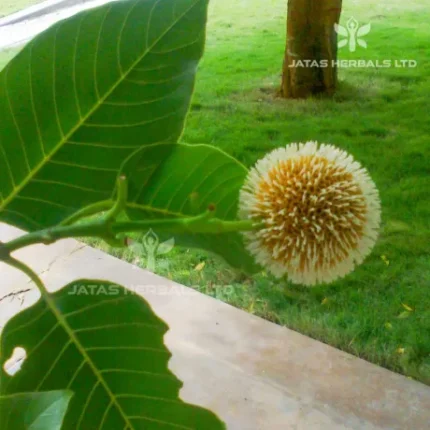Both nakha and vyaghranakha were described together in dhanvantarai nighantu under candanadi varga. Similarly, vyaghranakha and nakha are described together in madanapala nighantu. They are identified with Capparis zeylanica and Capparis sepiariarespectively. It is described by Sushruta (S.S.Ut.38/73) and Vagbhata (A.H.Ut.35/46) with the name Gridranakhi. Z. jujuba Lam. Var. fruiticosa Haines may be the Gridranakhi. P.V. Sharmaji considered C. sepiaria as Gridra Nakhi. But C. sepiaria is actually treated as Himsra and C.zeylamica as Vyaghranakhi.
Botanical Description – Climbing or scrambling shrub, 2-5 m long with young parts clothed with scarlet-brown rufous tomentum; hairs irregularly branched and soon falling off. Leaves simple, elliptic-oblong, rarely ovate or obovate, 2.5-12 cm long, 2-7 cm broad; petiole up to 1.5 cm long; stipule recurved, c. 4 mm long, yellowish-brown. Flowers supra axillary, 2 or sometimes 1 or 3, 1.5-2.5 cm across, usually in vertical row, the upper most largest and the oldest; pedicels 1.5-3.5 cm long, tomentose. Sepals 8-12 mm long, 5-8 mm broad, subequal, tomentose. Petals 12-18 mm long, 5-12 mm broad hairy on the outer surface. Stamens indefinite, filaments about twice as long as the petals. Gynophore 3-4.5 cm long, thickened in fruit. Fruit more or less globose, 3-4 cm in diameter, pericarp thick and strong; seeds many about 5 mm in diam.
Major Chemical Constituents– Leaves– β Carotene
Part Used- Root; leaf
Dosage- Decoction 50-100 ml
Research –
- A study was undertaken to explore the immunomodulatory activity of ethanolic and water extracts of Capparis zeylanica Linn. Leaves on neutrophil adhesion test, humoral response to sheep red blood cells, delayed-type hypersensitivity, phagocytic activity and cyclophosphamide-induced myelosuppression. Pre-treatment of water extract (300 mg/kg, oral) of Capparis zeylanica evoked a significant increase in neutrophil adhesion to nylon fibres. The augmentation of humoral immune response to sheep red blood cells by ethanolic and water extracts (150-300 mg/kg) is evidenced by increase in antibody titres in mice. A dose-related increase in both primary and secondary antibody titre was observed. Oral administration of ethanolic and water extracts of Capparis zeylanica leaves, at doses of 150 and 300 mg/kg in mice, dose dependently potentiated the delayed-type hypersensitivity reaction induced by sheep red blood cells. Immunomodulatory activity was also assessed by serological and haematological tests. Capparis zeylanica extracts prevented myelosuppression in mice treated with cyclophosphamide drug. The study comprised the acute toxicity and preliminary phytochemical screening of the ethanol and water extracts (Ghule B.V. et al., 2006).
- The present study was designed to screen antimicrobial activity of Capparis zeylanica The coarse material of C. zeylanica roots was successively extracted with petroleum ether, chloroform and ethanol using Soxhlet and macerated to form water extract. All extracts were screened for its antibacterial and antifungal activity using agar well diffusion method. The microorganisms used for antibacterial and antifungal activity were Bacillus pumillus (NCIM-2752), Staphylococcus aureus (NCIM-2901), Bacillus subtilis (NCIM-2063), Escherichia coli (NCIM-2256), Klebsiella pneumoniae (NCIM-2957), Proteus vulgaris (NCIM-2027), Candida albicans (MTCC-3018) and Aspergillus niger(MTCC-404). Gentamicin 5 mg/ml and Clotrimazol 5 mg/ml were used as standards. The extracts showed antimicrobial activity were subjected to minimum inhibitory concentration assay by two-fold dilutions method. Petroleum ether, chloroform, ethanol and water extract exhibited in-vitro antibacterial activity. None of the extracts showed antifungal activity (Choopde V.V. et al., 2008).
- The ethanol and water extracts of C. zeylanica leaves showed dose-dependent and significant (P<0.05) increases in pain threshold in tail-immersion test. Moreover, both the extracts (100-200 mg/kg) exhibited a dose-dependent inhibition of writhing and also showed a significant (P<0.001) inhibition of both phases of the formalin pain test. The water extract (200 mg/kg) significantly (P<0.01) reversed yeast-induced fever. Preliminary phytochemical screening of the extracts showed the presence of alkaloids, flavonoids, saponins glycosides, terpenoids, tannins, proteins and carbohydrates (Ghule et al., 2007).






Reviews
There are no reviews yet.